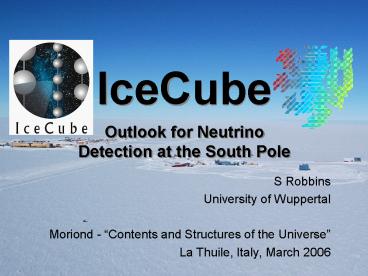IceCube PowerPoint PPT Presentation
Title: IceCube
1
IceCube
Outlook for Neutrino Detection at the South Pole
- S Robbins
- University of Wuppertal
- Moriond - Contents and Structures of the
Universe - La Thuile, Italy, March 2006
2
- Scientific Goals
- IceCube Status
- AMANDA Results
Amundsen-Scott South-Pole Station
3
- Alabama University, USA
- Bartol Research Institute, Delaware, USA
- Pennsylvania State University, USA
- UC Berkeley, USA
- UC Irvine, USA
- Clark-Atlanta University, USA
- University of Alaska, Anchorage, USA
- Univ. of Maryland, USA
- IAS, Princeton, USA
- University of Wisconsin-Madison, USA
- University of Wisconsin-River Falls, USA
- LBNL, Berkeley, USA
- University of Kansas, USA
- Southern University and AM College, Baton
Rouge, USA
The IceCube Collaboration
Japan
USA (14)
Europe (15)
- Chiba University, Japan
- University of Canterbury, Christchurch, NZ
New Zealand
- Universite Libre de Bruxelles, Belgium
- Vrije Universiteit Brussel, Belgium
- Université de Mons-Hainaut, Belgium
- Universiteit Gent, Belgium
- Humboldt Universität, Germany
- Universität Mainz, Germany
- DESY Zeuthen, Germany
- Universität Dortmund, Germany
- Universität Wuppertal, Germany
- MPI Heidelberg, Germany
- Uppsala University, Sweden
- Stockholm University, Sweden
- Imperial College, London, UK
- Oxford University, UK
- Utrecht University, Netherlands
ANTARCTICA
4
Physics Goals
5
Observing Neutrinos
Fermi acceleration of protons gives particle
spectrum dNp/dE E-2 Neutrino production at
source p? or pp collisions gives pions ? -gt
? ?? ? -gt e ?? ?e Neutrino flavors ?e
?? ?? 120 generic sources 111 after
oscillations
6
IceCube
7
?? detection principle
Optical module
- Mean ?-? angle is 0.7o at 1TeV
- Muon travels a large distance
- Interaction can be outside the detector
- Active volume is much larger than the detector
- Proposed by Markov 1960
10-20 m
8
?e ?? detection principle
Optical module
Charged-current interactions
Neutral-current interactions
9
Ice Properties
- Ice not uniform in depth (e.g. dust layers)
- Important to understand ice for analysis
Mean scattering length 25m
Mean absorption length 110m
10
Light Propagation
- Cherenkov cone from muon tracks
- Use timing information, accounting for propagation
Homogeneous ice
Depth Dependent ice properties
11
Hose reel
IceTop tanks
Hot-water drilling
12
IceCube Today
- 2004/2005 season
- New hot water drill
- First string deployed (string 21)
- Four IceTop stations installed (16 OMs)
- 60 OMs in deep ice, all 60
functioning - 2005/2006 season
- Modified drill
- 8 strings deployed
- 12 IceTop stations installed
- 480 OMs in deep ice and 48 OMs in
IceTop
Only IceTop tank
AMANDA
500 m
InIce string IceTop
13
String 21 Data
- First IceCube string, deployed January 2005
14
AMANDA
15
Diffuse Limits
- Measure the neutrino energy spectrum
- Search for a break in the spectrum
Results from one year (2000) of data Consistent
with Atmospheric neutrino expectation
Some AGN models excluded at 90 CL
Szabo-Protehoe 92 Stecker, Salamon. Space Sc.
Rev. 75, 1996 Protehoe. ASP Conf series, 121, 1997
E2??µ(E) lt 2.6107 GeV cm-2 sr-1 s-1
16
Point Source Search
- Neutrino sky map
17
Neutrinos from GRBs
Using space and time coincidence leads to a very
low background.
No observed signal Only 1 order of magnitude
above WaxmannBahcall prediction
18
Solar WIMPs
??
? ? ? ? ? ()
Freese, 86 Krauss, Srednicki Wilczek, 86
Gaisser, Steigman Tilav, 86
Silk, Olive and Srednicki, 85Gaisser, Steigman
Tilav, 86
- Neutralinos captured in the Sun
- These annihilate producing quarks and leptons
- And neutrinos, which we search for with IceCube
19
Neutralinos from the Sun
data from 2001
Sun
20
Conclusions
- 2005/6 was a successful deployment season
- Now have in total 604 optical modules installed
- Only 1 failure rate
- IceCube is on track for 1km3 neutrino observatory
- AMANDA has taken 10 years of data
- AMANDA continues to produce physics results
- No extraterrestrial neutrinos observed so far
- Stay tuned

